Why do I need another endodontic procedure?
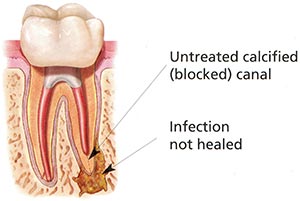 As occasionally happens with any dental or medical procedure, a tooth may no heal as expected after initial treatment for a variety of reasons:
As occasionally happens with any dental or medical procedure, a tooth may no heal as expected after initial treatment for a variety of reasons:
- Narrow or curved canals were not treated during the initial procedure.
- Complicated canal anatomy went undetected in the first procedure.
- The placement of the crown or other restoration was delayed following the endodontic treatment.
- The restoration did not prevent salivary contamination to the inside of the tooth.
In other cases, a new problem can jeopardize a tooth that was successfully treated. For example: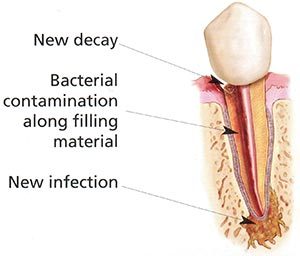
- New decay can expose the root canal filling material to bacteria, causing a new infection in the tooth.
- A loose, cracked or broken crown or filling can expose the tooth to new infection.
- A tooth sustains a fracture.
Is retreatment the best choice for me?
Whenever possible, it is best to save your natural tooth. Retreated teeth can function well for years, even for a lifetime.
Advances in technology are constantly changing the way root canal treatment is performed, so Dr. Shoushtari may use new techniques that were not available when you had your first procedure. He may be able to resolve your problem with retreatment.
As with any dental or medical procedures, there are no guarantees. Dr. Shoushtari will discuss your options and the chances of success before beginning retreatment.
What will happen during retreatment?
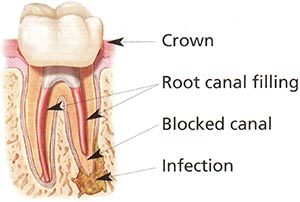 First, Dr. Shoushtari will discuss your treatment options. If you and Dr. Shoushtari choose retreatment, he will reopen your tooth to gain access to the root canal filling material. In many cases, complex restorative materials-crown, post and core material-must be disassembled and removed to permit access to the root canals.
First, Dr. Shoushtari will discuss your treatment options. If you and Dr. Shoushtari choose retreatment, he will reopen your tooth to gain access to the root canal filling material. In many cases, complex restorative materials-crown, post and core material-must be disassembled and removed to permit access to the root canals.
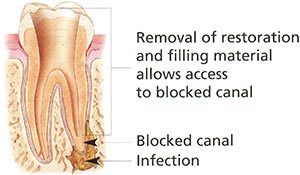 After removing the canal filling, Dr. Shoushtari can clean the canals and carefully examine the inside of your tooth using magnification and illumination, searching for any additional canals or unusual anatomy that requires treatment. Depending upon the amount of infection, root canal anatomy, and difficulty of the treatment, intra-canal medicament may be placed in the canals and you may have to come back for a second appointment to finish the root canal.
After removing the canal filling, Dr. Shoushtari can clean the canals and carefully examine the inside of your tooth using magnification and illumination, searching for any additional canals or unusual anatomy that requires treatment. Depending upon the amount of infection, root canal anatomy, and difficulty of the treatment, intra-canal medicament may be placed in the canals and you may have to come back for a second appointment to finish the root canal.
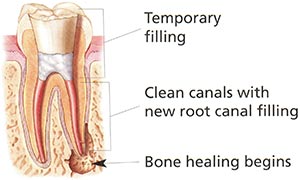 After cleaning the canals, Dr. Shoushtari will fill and seal the canals and place a temporary filling in the tooth. If the canals are usually narrow or blocked, Dr. Shoushtari may recommend endodontic surgery. This surgery involves making an incision to allow the tip of the root to be sealed.
After cleaning the canals, Dr. Shoushtari will fill and seal the canals and place a temporary filling in the tooth. If the canals are usually narrow or blocked, Dr. Shoushtari may recommend endodontic surgery. This surgery involves making an incision to allow the tip of the root to be sealed.
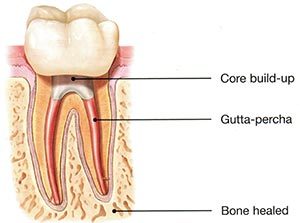 After Dr. Shoushtari completes retreatment, you will need to return to your dentist as soon as possible to have a new crown or other restoration placed on the tooth to protect and restore it to full function.
After Dr. Shoushtari completes retreatment, you will need to return to your dentist as soon as possible to have a new crown or other restoration placed on the tooth to protect and restore it to full function.
What are the alternatives to retreatment?
If nonsurgical retreatment is not an option, then endodontic surgery may sometimes be considered. This surgery involves making an incision to allow access to the tip of root. Endodontic surgery may also be recommended in conjunction with retreatment or as an alternative. Dr. Shouhstari will discuss your options and recommend appropriate treatment.
The only other alternative is extraction of the tooth. The extracted tooth must be replaced with a bridge, removable partial denture or implant to restore chewing function and to prevent adjacent teeth from shifting. Because these options require extensive surgery or dental procedures on adjacent healthy teeth, they can be far more costly and time consuming than retreatment and restoration of the natural tooth.
No matter how effective tooth replacements are-nothing is as good as your natural tooth. You’ve already made an investment in saving your tooth. The payoff for choosing retreatment could be a healthy, functioning natural tooth for many years to come.